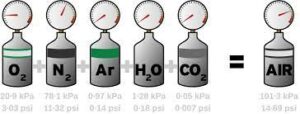Table of Contents
Introduction: Law Of Partial Pressures
The pressure imposed by a single gas in a mixture is referred to as its partial pressure. For example, if a container contains a combination of three gases, oxygen, nitrogen, and carbon dioxide, the pressure imposed by oxygen on the container’s walls is its partial pressure, just as the pressure exerted by nitrogen and carbon dioxide separately is their partial pressures. The total pressure applied on the container walls by the gas mixture is the sum of the partial pressures of the gases in the mixture (oxygen, nitrogen, and carbon dioxide).

In fact, a gas’s partial pressure is a measure of its thermodynamic activity. The partial pressure of a gas can reveal a variety of its features. The reactivity of a gas in a fixed volume, for example, is affected by its partial pressure. Gases, too, dissolve and disseminate in response to their partial pressures. This feature of gases also aids us in understanding and predicting the chemical interactions of gases in life. The partial pressures of oxygen and carbon dioxide are key factors in arterial blood gas testing.
The partial pressure of the gas is denoted by the sign P, with the gas symbol in the subscript. For instance, Po2 denotes the partial pressure of oxygen.
Dalton’s Partial Pressure Law
John Dalton, an English chemist, physicist, and meteorologist, established Dalton’s law of partial pressure in 1802. The overall pressure of a gas mixture is equal to the sum of the partial pressures of the constituent gases in the mixture, according to Dalton’s equation of partial pressure. Dalton’s law holds valid for optimal gas mixtures. Because molecules in an ideal gas are so far apart, they do not react. Dalton’s law is likewise followed by a combination of actual gases, but with a little variance.
For example, if an ideal gas mixture comprises nitrogen, hydrogen, and oxygen, the total pressure exerted by the ideal gas mixture is –
PN2 + PH2 + PO2 = Ptotal
- Ptotal denotes the total pressure of the ideal gas combination.
- PN2 = Nitrogen partial pressure
- PH2 = Hydrogen partial pressure
- PO2 = Oxygen partial pressure
Dalton’s partial pressure law may also be represented in terms of a gas’s mole fraction in a mixture. The mole fraction of a gas is defined as the number of moles of that gas divided by the total number of moles of gas in the mixture, and it is sometimes abbreviated as x.
Pgas 1 = x1PTotal
x1 =mole fraction of gas 1=moles of gas 1/total moles of gas
FAQs on Law of partial pressures
Q. What is the Purpose of Dalton’s Law?
ANS: Dalton’s law in both formulations is immensely beneficial in solving a variety of issues, including:
- When you know the mole ratio and total pressure of a gas, you may calculate its partial pressure.
- If you know the partial pressure and total pressure of a gas, you may calculate its moles.
- If you know the partial pressures of the components, you can calculate the total pressure.
Q. What exactly do you mean by “partial pressure”?
ANS: The pressure imposed by a single gas in a mixture is referred to as its partial pressure.





